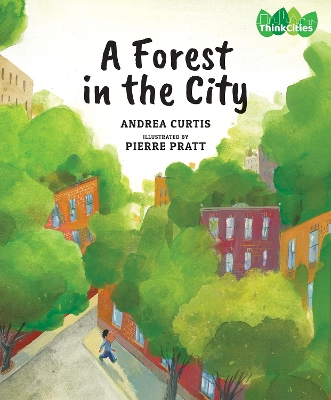ThinkCities
1 primary work • 2 total works
Book 4
A splash of paint, a place to sit, a popup park or playground bring life and a sense of fun to our cities.
Neighborhoods where people look out for each other, eat together, make art and build community are healthier, happier, greener and cleaner. Journey around the world to discover how people have been dreaming up new ways to ensure their cities and neighbourhoods are creative, inclusive and environmentally sustainable.
These placemaking ideas can be big — like the skateboard park built on the grounds of an orphanage in Nairobi, Kenya — or small — like the painted rock snake that winds along a beach in Toronto, Ontario. Together, we can create public spaces where everyone belongs. Includes a list of ideas for children to get involved in their neighborhoods, along with a glossary and sources for further reading.
The ThinkCities series is inspired by the urgency for new approaches to city life as a result of climate change, population growth and increased density. It highlights the challenges and risks cities face, but also offers hope for building resilience, sustainability and quality of life as young people advocate for themselves and their communities.
Key Text Features
fact
further information
further reading
glossary
historical context
illustrations
resources
references
Correlates to the Common Core State Standards in English Language Arts:
CCSS.ELA-LITERACY.RI.6.1
Cite textual evidence to support analysis of what the text says explicitly as well as inferences drawn from the text.
CCSS.ELA-LITERACY.RI.6.6
Determine an author's point of view or purpose in a text and explain how it is conveyed in the text.
This beautiful book of narrative non-fiction looks at the urban forest and dives into the question of how we can live in harmony with city trees.
“Imagine a city draped in a blanket of green … Is this the city you know?”
A Forest in the City looks at the urban forest, starting with a bird’s-eye view of the tree canopy, then swooping down to street level, digging deep into the ground, then moving up through a tree’s trunk, back into the leaves and branches.
Trees make our cities more beautiful and provide shade but they also fight climate change and pollution, benefit our health and connections to one another, provide food and shelter for wildlife, and much more. Yet city trees face an abundance of problems, such as the abundance of concrete, poor soil and challenging light conditions.
So how can we create a healthy environment for city trees? Urban foresters are trying to create better growing conditions, plant diverse species, and maintain trees as they age. These strategies, and more, reveal that the urban forest is a complex system—A Forest in the City shows readers we are a part of it.
Includes a list of activities to help the urban forest and a glossary.
The ThinkCities series is inspired by the urgency for new approaches to city life as a result of climate change, population growth and increased density. It highlights the challenges and risks cities face, but also offers hope for building resilience, sustainability and quality of life as young people act as advocates for themselves and their communities.
Key Text Features
diagrams
author's note
glossary
sources
definitions
Correlates to the Common Core State Standards in English Language Arts:
CCSS.ELA-LITERACY.RI.4.7
Interpret information presented visually, orally, or quantitatively (e.g., in charts, graphs, diagrams, time lines, animations, or interactive elements on Web pages) and explain how the information contributes to an understanding of the text in which it appears.

